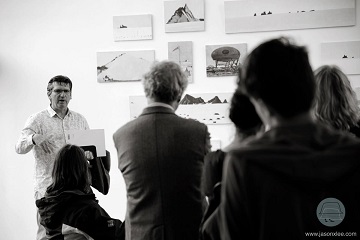 |
| Alien, John Kelly, cor-ten steel, 2006, Photo by Meg Eloise Connell, 2016 |
John and his wife Christina have lived at their Reen home in West Cork for 13 years now and had their large land extension which is now home to a number of artworks for the past 5.
To begin the tour we walked up some stone steps, past Kelly's glasshouse model of the Tate, through a small tunnel and across an "under-construction" sky garden, like a miniature of the one at Liss Ard Estate, and out on to a grassy field with a panoramic view of South Reen's seascape.
 |
| Grassy walkway up through John Kelly's property, Photo by Meg Eloise Connell, 2016 |
Closer by Big Head, a cor-ten steel piece sits on the grass, a part of Kelly's series of action in rejection of the branding of the arts by the Australia Council, and his abstraction of their logo.
Finally to the right, silhouetted against the backdrop of the islands, is Cow Up a Tree. Probably one of the world's widest travelled contemporary sculptures, it now stands surreal and striking in the Irish countryside. Kelly's favourite view of the giant sculpture is not one you'd expect; from a trampoline, hidden at ground level amongst the long grass uphill from the sculpture.
 |
| John Kelly, Cow up a Tree in South Reen, Bronze, 1999, Photo from JohnKellyArtist.com |
It quickly became evident while we were talking that every piece he creates has an extensive story behind it. He says the way his work evolves "it's always based in series of works and always translates from one medium to another."
 |
| John Kelly talking at Uillinn: West Cork Arts Centre, Photo by Jason Lee, 2016 |
John Kelly is known for injecting his clever humour into a lot of his art, but the stories behind his work also run deep and are intellectually stimulating. His "Dobell's cows", for instance, are about more than abstracted cows put in unusual positions.
 |
| John Kelly, Two Men Lifting a Cow, Etching, 2004 |
Kelly is a multifaceted artist. With each area he delves into there are times of year and circumstances he prefers or avoids.
 |
| John Kelly's studio in Reen, West Cork, photo by Meg Eloise Connell, 2016 |
Writing, he enjoys when he's travelling. He wrote blogs for the Guardian whilst on his residency in Antarctica, documenting and reflecting on his journey and work as he went. He says writing is "a great way to order your thoughts and make you think deeply about things that you're seeing, so that you're not just the passive viewer," and that he loves the contemplation it involves.
When it comes to print-making, it is the technical aspect he likes best, trying to make something work "in a backwards sort of fashion." Print-making requires the artist to first create their desired final image in reverse, as the process involves transferring ink from the face of one material to another, producing a mirror image. John enjoys the technical challenge to fit his ideas into the limitations of print-making.
The collaborative element of sculpture is his favourite part. In the case of Kelly's sculpture, predominantly large metal based creations, he has to work together with foundries in order to bring his art to life. He laughed saying he's "always trying to make the materials probably do more than the foundry will say they can do," and that "you always have to resolve problems, whether it be engineering or just technical issues with the sculptures being out in the public, so there's a real collaborative effort," which he likes.
 |
| John Kelly's studio in Reen, West Cork, photo by Meg Eloise Connell, 206 |
 |
| John Kelly painting en plein air in Antarctica, photo by Richard Youd, 2013 |
His adventure was partly a result of Kelly wanting to escape the "padded cell" that was his studio. He says there are so many artists and studios now that are "not dissimilar to what you'd consider a bureaucratic office" where projects are being managed as if they're part of a corporation.
"It kind of struck me at a significant point where I was making a project for the Göteborg Biennial that I was actually managing this thing I wasn’t actually making very much of it. A big sculpture, I’d designed it, but I’d lost something. So that’s when I started painting the landscape again just to go back and just connect again."
 |
| John Kelly talking at Uillinn: West Cork Arts Centre, Photo by Jason Lee, 2016 |
John Kelly's A Group Show will be exhibited at Uillinn: West Cork Arts Centre until the 31st of August 2016.
Kelly's next big sculpture Man Lifting Cow will be unveiled in Melbourne in September, 2016.
Piece written by Meg Eloise Connell
For news and current/upcoming events visit: West Cork Arts Centre Website
Uillinn: West Cork Arts Centre Facebook page
Uillinn: West Cork Arts Centre Youtube channel
Or come visit us in person Monday to Saturday 10:00-16:45
No comments:
Post a Comment